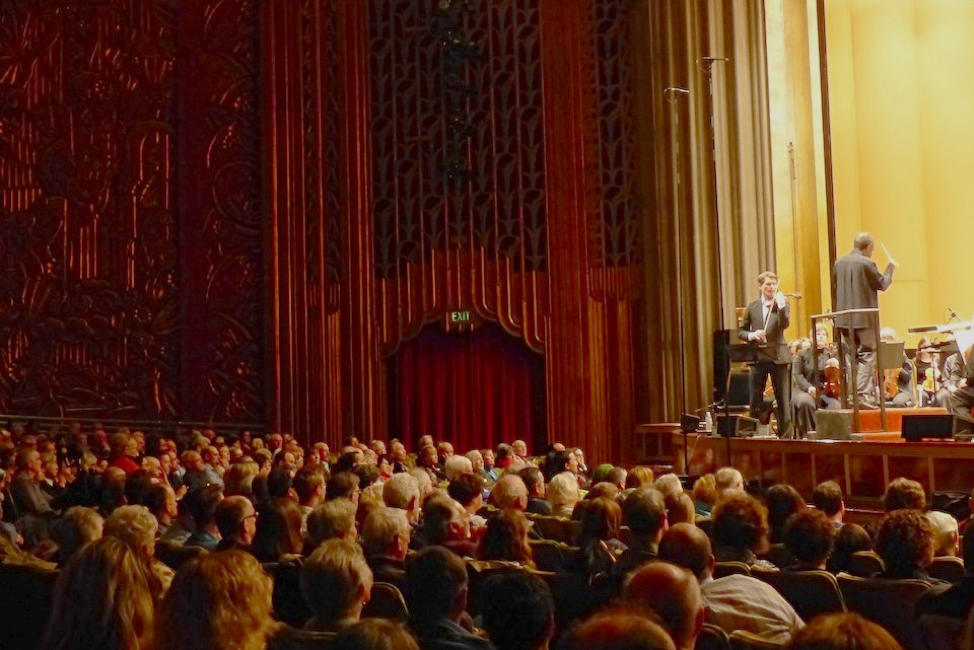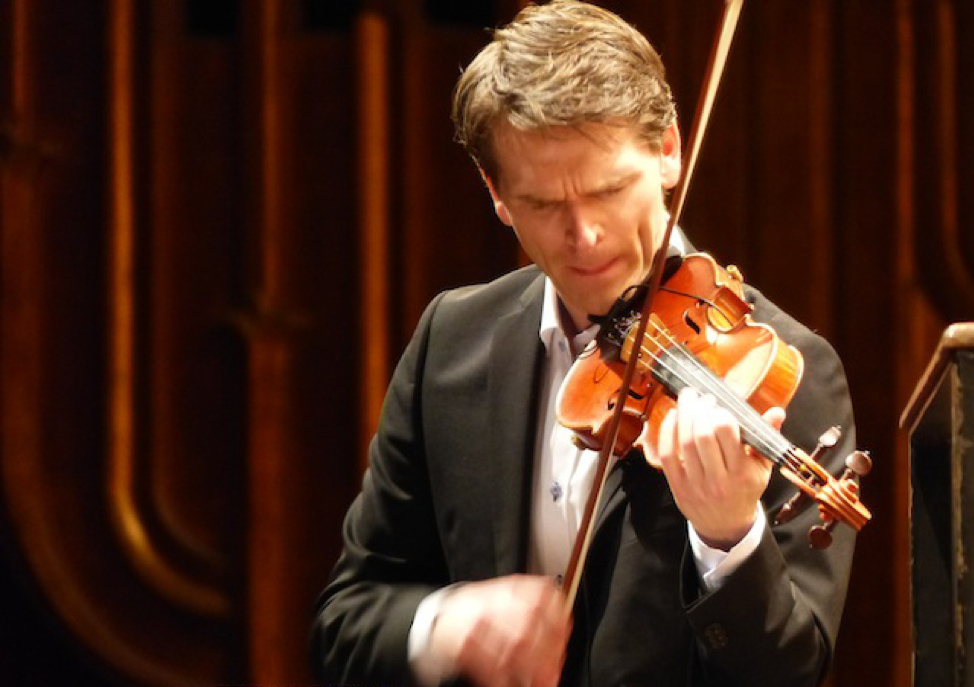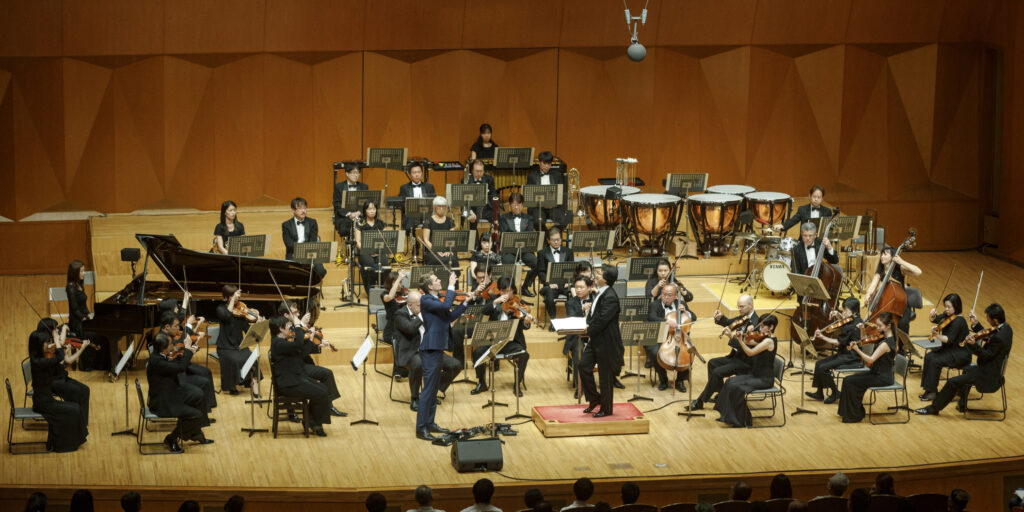MADS TOLLING WITH SYMPHONY
Mads’ Violin Concertos
In 2013, Mads received a call from the music director of the Oakland Symphony Orchestra, Michael Morgan. Michael wanted to discuss a commissioning project designed for non-classical composers writing for full symphony orchestra. Mads eventually accepted the commission, which ended up being a 25-minute, 3 movement jazz violin concerto to be performed with the Oakland Symphony. The performance took place at the Paramount Theatre on February 20, 2015. Over two thousand people in attendance were treated to an unforgettable performance of the world premiere of Begejstring, which in Danish means Excitement.
In 2017, Mads was once again commissioned to write a violin concerto, Yggdrasil. This time for conductor Lawrence Kohl and The Pacific Chamber Ensemble. The piece was written for roughly the same orchestration as Aaron Copland’s original score for Appalachian Spring – 13-player version. Mads added his violin sounds and a percussionist to the mix. Yggdrasil is named after the Tree of Life in Norse Mythology, and its jumping off point comes from the oldest song ever notated in Scandinavia, “I Dreamt Me a Dream.” Two premiere performances took place in 2018 in the San Francisco Bay Area.
Mads has performed his violin concertos with numerous symphony orchestras around the U.S. and internationally headlining the Jazz Street Festival in Japan with Orchestra Ensemble Kanazawa.



Reviews and Reactions
“There was plenty of exuberance in the writing, and Tolling – who spent several years as a member of the Turtle Island String Quartet – deployed his amplified violin with dazzling technical assurance.”
– Joshua Kosman, San Francisco Chronicle
“…A Cross-Genre Genius…”
– Adam Broner, Piedmont Post
“The central movement’s sighing strings, atmospheric piano and bluesy clarinet solo suggested a languid stroll down Broadway; in the finale, Tolling’s painterly dabs of sound — pizzicato strings, blaring brass, and well-placed percussion — came together to give the score plenty of swing.”
– Georgia Rowe, San Jose Mercury
“Mads Tolling’s concerto was a great hit with both orchestra musicians and audience. It integrates soloist and orchestra in a way that makes the orchestra a full participant in the jazz idioms. The notation of solos is clear and requires no improvisation from the players, yet it sounds very free and spontaneous.I would very highly recommend the piece to any orchestra seeking to diversify its repertory with an accessible and well-crafted piece. And of course, Mr. Tolling’s performance is excellent.”
– Michael Morgan, Music Director, Oakland East Bay Symphony
Listen to Excerpts of Begejstring.
Michael Morgan and Mads Tolling discuss the joys and challenges of writing and conducting in cross-genre styles.
In Mads own words
Program Notes for Begejstring (2015)
Begejstring is a Danish word, which translated to English, means excitement, enthusiasm, gusto, and passion. I have entitled my composition Begejstring because it encompasses who I am, what I am, and where I am in this moment, with my music and my evolving growth as an artist. Having grown up in Copenhagen, my Danish heritage and background is inherent to my perspective as a musician and a composer, and provides me with the foundation from which I continue to expand my landscape and horizons. The excitement I felt when I wrote my first piece in high school for my band was pivotal. The expression of something so personal, the connection with friends and band mates, and ultimately the audience, was an emotional epiphany.
Since that time, I have had extraordinary opportunities to continue that sharing process, while challenging myself along the way, writing for string quartets, various chamber music groups, jazz combos and even Big Band. Composing for symphony is yet another challenge, which I have embraced with Begejstring. Integrating groove-based music with jazz, fiddle styles, and improvisation, fusing it with sixty-seven other musicians, and communicating it all to an audience is a fresh adventure for me. I am appreciative of everyone who is taking this journey with me, and look forward to the discovery of a new destination.
Movement I, “Muligheder” [Possibilities]
The possibilities are endless in music. Where to go, how long to stay, what to say…. and we, the musicians, decide. This movement highlights different instrument groups of the symphony and juxtaposes groove-based ostinatos in the heavy brass with chamber music-like fugues of the string quartet. It reaches its climax with a challenge between violin and trumpet gradually ascending towards the end.
Movement II, “Forståelse” [Understanding]
Understanding why we play music, what it is we have to say, who we are as musicians and artists. These questions can only be answered over a lifetime. I would like to thank my mentors who have helped me find my way to a deeper understanding of music, and myself. Thanks to Stanley Clarke, Jean-Luc Ponty, members of the Turtle Island Quartet, my Mom and Dad, who first introduced me to jazz listening to a cassette tape of Miles Davis.
The second movement highlights the simplicity of a beautiful melody and its unhurried, intimate message of calm, serenity, and allure. The intro’s moaning blues lines in clarinet and violin plant the seed for things to come.
Movement III, “Jubel” [Jubilation]
Sometimes as a musician, we reach a level of joy when playing that words cannot describe. Those are rare moments to come by, to be cherished even more because of their fleeting occurrences. The third movement is a bit of a fiddle hoedown that crosses into a boogie-woogie blues. All men on deck, senses heightened, watch out!
Begejstring is dedicated to all those who have made me feel that fervor, zeal, and excitement when sharing music on this odyssey I have been on ever since I started playing the violin at six years old.
Instrumentation
2 flutes – with doubling
2 oboes – with doubling
2 clarinets – with doubling
2 bassoons – with doubling
4 horns
3 trumpets
3 trombones
1 tuba
1 harp
1 pianist
1 timpani
1 or 2 percussionists
12-10-8-8-6 in the strings
Making Yggdrasil and Presenting Musical Mythos – Vikings to Shakers.
Program Notes for Yggdrasil (2018)
The mighty tree Yggdrasil marks the center of Norse cosmology. It connects the rest of the cosmos, including the Nine World, in its branches and roots. Tolling’s concerto for violin and chamber orchestra acts similarly to the mythological ash tree by joining various musical styles, including classical, jazz, latin and fiddle music. It is written for almost the same orchestration as Copland’s original orchestration of Appalachian Spring – with the addition of percussion and solo violin parts.
The work opens with “Jeg Drømte mig en drøm” [I dreamt me a dream], the oldest known song in the Nordic countries. The second movement Bifrost, is named after the rainbow bridge that connects Midgard (Earth) with Asgard, the realm of the gods. Third and fourth movements “Hugin” and “Munin,” depict a pair of ravens that fly all over Midgard, surveying and bringing information to Odin.
Instrumentation
1 flute – with doubling
1 clarinet – with doubling
1 bassoon
1 pianist
1 percussionist
2 violin I
2 violin II
2 violas
2 cellos
1 double bass